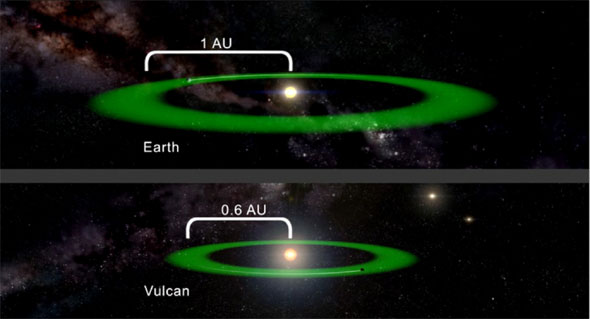http://en.wikipedia.org/wiki/Vulcanoid_asteroid wrote:
<<The vulcanoids are a hypothetical population of asteroids that may orbit the Sun in a dynamically stable zone inside the orbit of the planet Mercury. They are named after the hypothetical planet Vulcan, whose existence was disproven in 1915. The vulcanoids are thought to exist in a gravitationally stable band inside the orbit of Mercury, at distances of 0.06–0.21 AU from the Sun. All other similarly stable regions in the Solar System have been found to contain objects, although non-gravitational forces such as radiation pressure, Poynting–Robertson drag and the
Yarkovsky effect may have depleted the vulcanoid area of its original contents. The outer edge of the vulcanoid zone is approximately 0.21 AU from the Sun. More distant objects are unstable due to the gravitational influence of Mercury and would be perturbed into Mercury-crossing orbits on timescales of the order of 100 million years. The inner edge is not sharply defined: objects closer than 0.06 AU are highly susceptible to Poynting–Robertson drag and the Yarkovsky effect, and even out to 0.09 AU vulcanoids would have temperatures of 1,000 K or more, which is hot enough for evaporation of rocks to be the limiting factor in their lifetime.
In 1998, astronomers analysed data from the SOHO spacecraft's LASCO instrument, which is a set of three coronagraphs. The data taken between January and May of that year did not show any vulcanoids brighter than magnitude 7. This corresponds to a diameter of about 60 kilometres, assuming the asteroids have an albedo similar to that of Mercury. In 2000, planetary scientist Alan Stern performed surveys of the vulcanoid zone using a Lockheed U-2 spy plane. The flights were conducted at a height of 21,300 metres during twilight. In 2002, he and Dan Durda performed similar observations on an F-18 fighter jet. They made three flights over the Mojave desert at an altitude of 15,000 metres and made observations with the Southwest Universal Imaging System—Airborne (SWUIS-A). The MESSENGER space probe may provide evidence regarding vulcanoids. Its opportunities will be limited because its instruments need to be pointed away from the Sun at all times to avoid damage. The spacecraft has already taken a few of a planned series of images of the outer regions of the vulcanoid zone.
The volume of the vulcanoid zone is very small compared to that of the asteroid belt. Collisions between objects in the vulcanoid zone would be frequent and highly energetic, tending to lead to the destruction of the objects. The most favourable location for vulcanoids is probably in circular orbits near the outer edge of the vulcanoid zone. Vulcanoids are unlikely to have inclinations of more than about 10° to the ecliptic. Mercury trojans, asteroids trapped in Mercury's Lagrange points, are also possible.
Any vulcanoids that exist must be relatively small. Previous searches, particularly from the SOHO spacecraft, rule out asteroids larger than 60 kilometres in diameter. The minimum size is about 100 metres; particles smaller than 0.2 μm are strongly repulsed by radiation pressure, and objects smaller than 70 m would be drawn into the Sun by Poynting–Robertson drag. Between these upper and lower limits, a population of asteroids between 1 kilometre and 25 kilometres in diameter is thought to be possible. They would be almost hot enough to glow red hot.
There is evidence that Mercury was struck by a large object relatively late in its development, a collision which stripped away much of Mercury's crust and mantle, and explaining the thinness of Mercury's mantle compared to the mantles of the other terrestrial planets. If such an impact occurred, much of the resulting debris might still be orbiting the Sun in the vulcanoid zone.
Vulcanoids, being an entirely new class of celestial bodies, would be interesting in their own right, but discovering whether or not they exist would yield insights into the formation and evolution of the Solar System. If they exist they might contain material left over from the earliest period of planet formation, and help determine the conditions under which the terrestrial planets, particularly Mercury, formed. In particular, if vulcanoids exist or did exist in the past, they would represent an additional population of impactors that have affected no other planet but Mercury, making that planet's surface appear older than it actually is. If vulcanoids are found not to exist, this would place different constraints on planet formation and suggest that other processes have been at work in the inner Solar System, such as planetary migration clearing out the area.>>

